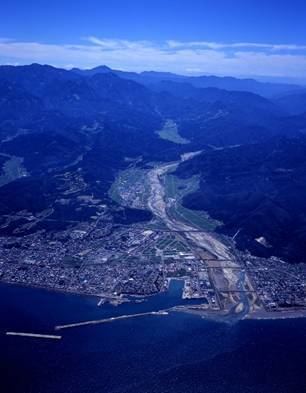Country Japan Prefecture Niigata Prefecture | Phone number 025-552-1511 Population 44,684 (Jun 2016) | |
 | ||
Region Chūbu (Kōshin'etsu) (Hokuriku) Time zone Japan Standard Time (UTC+9) Address 1-2-5 Ichinomiya, Itoigawa-shi, Niigata-ken 941-8501 Website www.city.itoigawa.lg.jp Weather 7°C, Wind SW at 11 km/h, 64% Humidity Points of interest Shulman Hiuchi Ski Area, Oyashirazu Pier Park ‑ Furusato, Renge Hot Spring, Mount Hiuchi, Cliffs of Oyashirazu | ||
Itoigawa (糸魚川市, Itoigawa-shi) is a city located in north-central Niigata Prefecture, in the Hokuriku region of Japan. As of 30 June 2016, the city had an estimated population of 44,684 and a population density of 59.9 persons per km². Its total area was 746.24 square kilometres (288.12 sq mi).
Contents
- Map of Itoigawa Niigata Prefecture Japan
- Geography
- Surrounding municipalities
- History
- Oldest known jadeite using culture
- Economy
- Education
- Railway
- Highway
- Local attractions
- Noted people from Itoigawa
- References
Map of Itoigawa, Niigata Prefecture, Japan
Geography
Itoigawa is located in the far southwestern corner of Niigata Prefecture, bordered by the Sea of Japan to the north, Nagano prefecture to the south, and Toyama Prefecture to the west. Parts of the city are within the borders of the Chūbu-Sangaku National Park or the Myōkō-Togakushi Renzan National Park. Itoigawa is also famous for its jade which can be found on local beaches. Itoigawa also lends its name to the Itoigawa-Shizuoka Tectonic Line, a major fault that runs from Itoigawa, through Lake Suwa to the city of Shizuoka in Shizuoka Prefecture, forming the western border of the Fossa Magna.
Surrounding municipalities
History
The area of present-day Itoigawa was part of ancient Echigo Province. Historically, Itoigawa lies at the end of the famous shio no michi (salt road) that supplied salt to ancient Edo (Tokyo) via Shinano Province. During the Edo period, Itoigawa was the castle town for Itoigawa Domain. After the Meiji restoration, Itoigawa became a town within Nishikubiki District, Niigata.
The modern city was created on June 1, 1954. On April 1, 2005, the towns of Nō and Ōmi (both from Nishikubiki District) were merged into Itoigawa.
Oldest known jadeite-using culture
A great many jadeite beads and axe heads as well as the remains of jadeite workshops from the Neolithic era have been uncovered in Itoigawa. These beads and axes were traded throughout Japan and the Korean Peninsula and were produced by the world's oldest known jadeite-using culture, centered on the Itoigawa region.
Economy
Commercial fishing and the production of limestone and cement are the mainstays of the local economy.
Education
Itoigawa has seventeen public elementary schools and four public middle schools. There are three public high schools, and also two special education schools.
